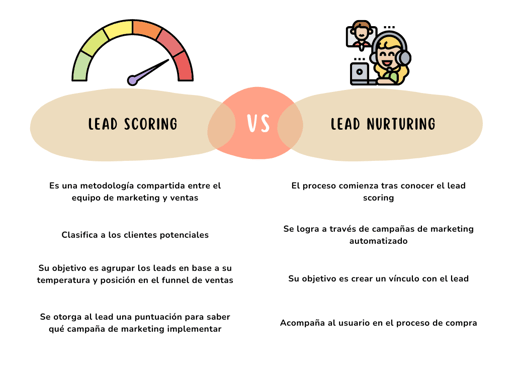Index Content
Both lead scoring and lead nurturing are marketing techniques that are carried out using automation tools. It is worth remembering that the term lead in digital marketing refers to contacts who have visited a website and have left their data in exchange for content. In other words, contacts who show an initial interest in the company. These must be studied to determine their quality and conversion management. Depending on the stage they are at in the sales funnel, they are classified as leads (discovery stage), MQLs (consideration stage) or SQLs (decision stage). The task of lead scoring is precisely to classify leads into groups and place them in a database, taking into account their affinity with the buyer persona. Lead nurturing is used when these records are known and you want to work with them.
Often these concepts are confused or considered the same, but their differences are evident. Moreover, they are applied in different customer life cycles. While lead scoring serves to order leads in relation to their predisposition to purchase, lead nurturing aims to accompany them in the process. This is achieved through a follow-up that strengthens the customer's relationship with the company and establishes a communication channel to gain their trust. In In Inbound Marketing, programmed email sending platforms and personalised content are essential to build user loyalty.
why should lead scoring and lead nurturing be used?
In every company, lead management is recommended to guide the user through the sales funnel. These processes enhance the benefits by providing greater opportunity for customers to buy. To succeed, the data must consist of monitoring, classification, analysis and use. The first objectives are met by lead scoring through its user scoring system, but the use of data is done by lead nurturing: it decides the marketing strategies that must be present in the lead conversion process. Both methodologies need each other, one does not work without the other. Starting a lead nurturing action without knowing the results of the scoring is like walking blindly. It would mean a problem of organisation, lack of engagement and a lack of knowledge of the company's database.
Differences between lead scoring and lead nurturing
 what is lead scoring for?
what is lead scoring for?
- It analyses the quality of the leads and knows their stage in the buying process.
- It enables the flow of potential customers towards purchase because it involves the sales and marketing teams.
- Segments and organises the database.
- Saves work for the sales team as they focus only on qualified customers.
- It orientates marketing actions by targeting the buyer persona.
- It implements automated marketing actions to subsequently carry out lead nurturing.
what is lead nurturing for?
- Filter qualified leads so that they reach the sales team.
- Activates workflows to create an offer of personalised content according to their stage in the sales funnel.
- Enables customer personalisation.
- Improves communication between the customer and the company, which in turn increases the chances of customer loyalty.
- It is a multi-channel process.
what are the elements of lead nurturing?
Lead nurturing is achieved through multi-channel communication with the customer. It is a process that combines several marketing actions through automation tools. To create this system, the convergence of the following elements is advisable:
- Lead scoring data: If lead scoring is worked before lead nurturing, results will be obtained that will allow knowing when and how to address each user. These must be kept updated and optimised as many times as necessary.
- Remarketing: These ads are expensive, but can be used to create personalised experiences for buyers.
- Multichannel: All channels that make up the marketing strategy should be cohesive, and the customer should be able to contact the company from any of them.
- Website optimisation: In digital marketing, the company's website is also its calling card, which is why interactions through it should be expanded and the user experience should be reinforced.
- Automation: Automation tools are necessary to achieve a multichannel communication. Automating a workflow saves time and money for the company.
- Content marketing: By knowing the customer's profile, content can be created based on their tastes and preferences. This process must also be multichannel. It is a commitment to offer relevant and quality information.
.jpg?width=400&name=pexels-photo-6476589%20(1).jpg)
how to do lead nurturing?
We start from the premise that improving relationships with leads is fundamental for them to end up making a purchase. Therefore, after knowing the lead scoring, it is advisable to forge a path to consolidate lead nurturing. Knowing potential customers can provide a personalised experience. Automated marketing can ensure its effectiveness by sending newsletters, emails, offers... These are the steps to implement a lead nurturing system:
1. Choose the type of lead nurturing
Lead nurturing ensures purchases in a non-intrusive way. Depending on the lead nurturing system used, one model or another will be selected. The traditional model is characterised by collecting data and deciding when to send it to the sales department. The sales-first model sends the leads directly to the sales team. If the decision is wrong, the customer returns to the marketing team. Finally, the gatekeeper model is based on stopping the nurturing if the sale is not closed through the traditional model. After this, the data is re-analysed and strategies are applied to capture the lead's interest.
2. Implementing an automated workflow
After deciding on the lead nurturing model, a workflow is developed depending on the lead and its stage of the journey. Using automation tools such as HubSpot or GetResponse, an ongoing content calendar is established. Email marketing is a key tool in lead nurturing.
3. Deciding on lead nurturing strategies
Lead nurturing should be carried out through a combination of different strategies, the most commonly used of which are:
- Social networks: They allow you to establish contact with your customers. Platforms such as Twitter or Instagram facilitate interaction in real time. You can also create audiovisual content and attract the attention of the lead immediately.
- Newsletter: Subscribing to a newsletter can be the beginning of a close relationship between the customer and the company. Its frequency is monthly and ensures regular contact with the leads. These publications can inform about news, offers, blogs of interest, promotions or educational content.
- Drip campaign: Allows the automated sequence of personalised emails. Designing it involves studying the behaviour of each lead and offering content related to their movements on the website.
Tools for lead nurturing
Hubspot: This platform is associated with Inbound Marketing and provides the user with tools for landing page, web analysis, mailing, SEO optimisation and social media marketing. It is an interesting option for both lead scoring and lead nurturing.
Pardot: This marketing tool connects to search engines such as Yahoo, Bing and, of course, Google. It checks search engine rankings, but also offers the possibility of creating marketing campaigns and automating the sending of emails.
Sendinblue: It is a tool for marketing automation. It creates workflows based on lists, navigation and user segmentation. It is a low-cost alternative to tools like Mailchimp.





